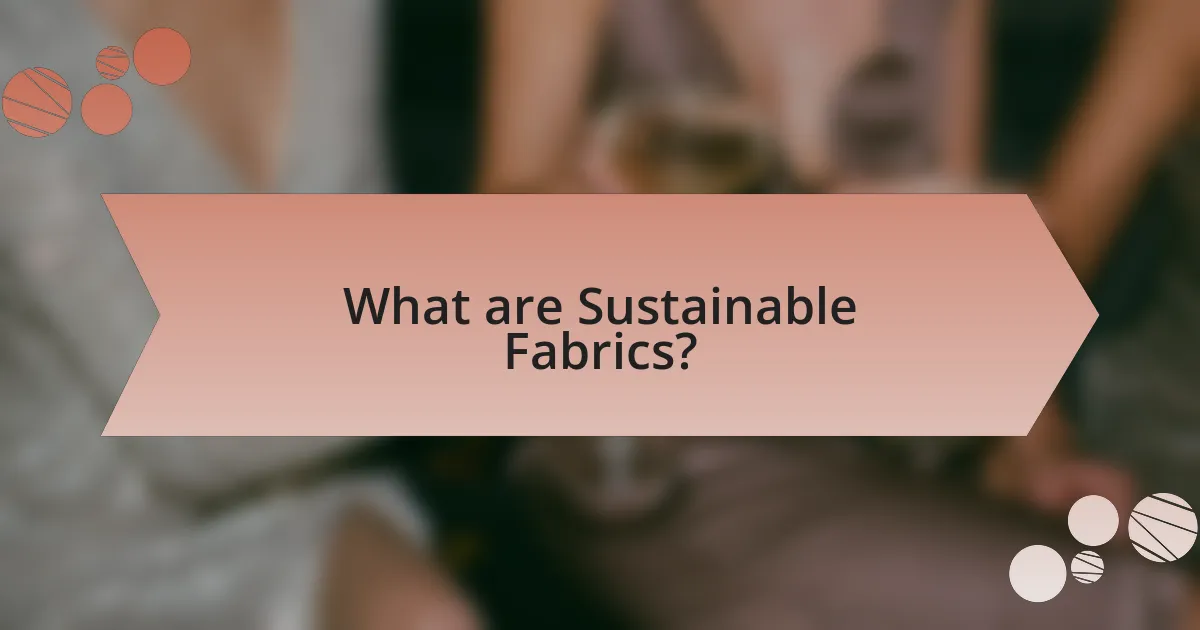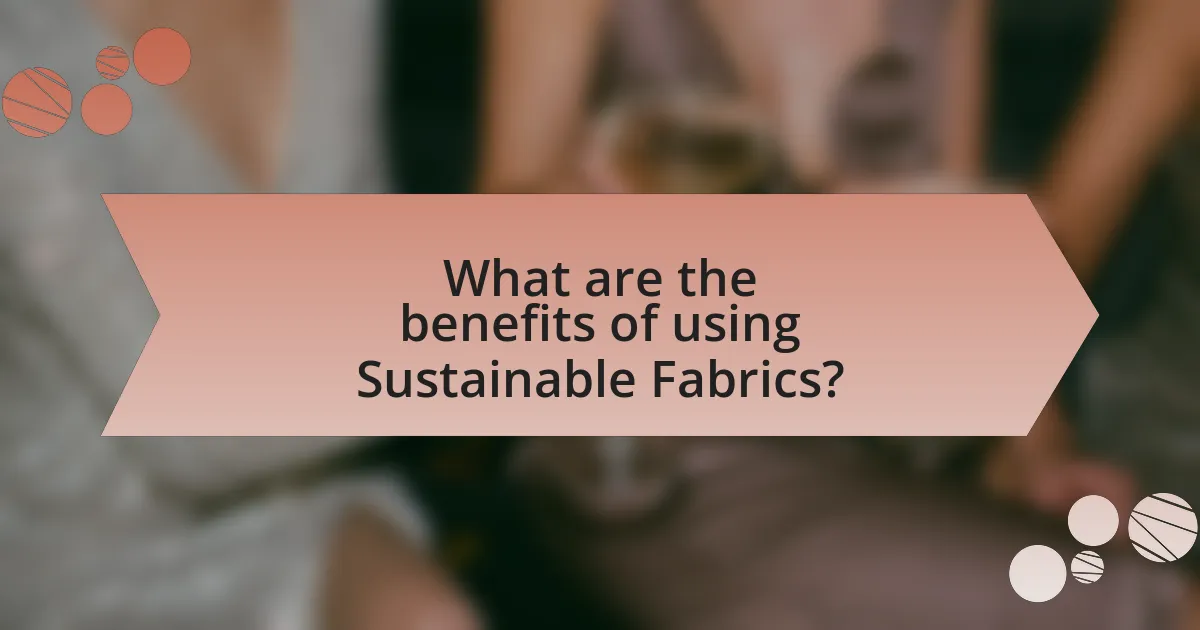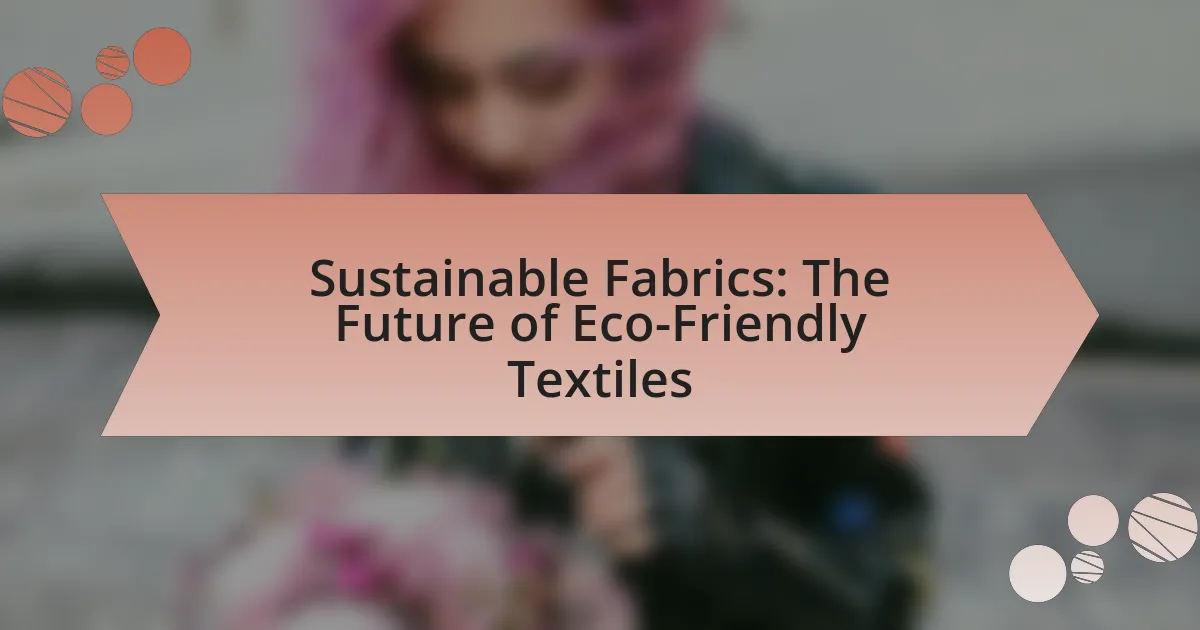Sustainable fabrics are textiles produced with minimal environmental impact, utilizing renewable resources and eco-friendly processes. This article explores the characteristics of sustainable fabrics, highlighting their differences from conventional textiles, commonly used materials, and the eco-friendly production methods that contribute to environmental conservation. It also examines the increasing demand for sustainable fabrics driven by consumer awareness, the economic advantages they offer, and the challenges faced in their production and acceptance. Additionally, the article discusses innovations in sustainable fabric production and best practices for incorporating these eco-friendly textiles into everyday wardrobes.

What are Sustainable Fabrics?
Sustainable fabrics are textiles produced with minimal environmental impact, utilizing renewable resources and eco-friendly processes. These fabrics often come from organic materials, such as organic cotton, hemp, or recycled fibers, which reduce pollution and resource consumption. For instance, organic cotton uses 91% less water than conventional cotton and avoids harmful pesticides, making it a more sustainable choice. Additionally, sustainable fabrics can include innovative materials like Tencel, derived from sustainably sourced wood pulp, which is produced in a closed-loop process that recycles water and solvents. This approach not only conserves resources but also minimizes waste, reinforcing the validity of sustainable fabrics as a crucial component in eco-friendly textiles.
How do sustainable fabrics differ from conventional textiles?
Sustainable fabrics differ from conventional textiles primarily in their production processes and environmental impact. Sustainable fabrics are made from renewable resources, such as organic cotton or recycled materials, which reduce reliance on fossil fuels and minimize waste. In contrast, conventional textiles often utilize non-renewable resources and chemical-intensive processes that contribute to pollution and resource depletion. For instance, the production of conventional cotton typically involves significant pesticide use, while organic cotton farming avoids harmful chemicals, promoting biodiversity and soil health. This distinction highlights the commitment of sustainable fabrics to environmental stewardship and social responsibility.
What materials are commonly used in sustainable fabrics?
Common materials used in sustainable fabrics include organic cotton, hemp, linen, Tencel (lyocell), and recycled polyester. Organic cotton is grown without synthetic pesticides or fertilizers, reducing environmental impact. Hemp requires minimal water and no pesticides, making it a highly sustainable option. Linen, derived from flax plants, is biodegradable and uses less water than conventional cotton. Tencel is produced from sustainably sourced wood pulp and is known for its low environmental footprint. Recycled polyester, made from post-consumer plastic bottles, helps reduce waste and conserves resources. These materials collectively contribute to the eco-friendliness of sustainable textiles.
How is the production process of sustainable fabrics more eco-friendly?
The production process of sustainable fabrics is more eco-friendly because it utilizes renewable resources and minimizes environmental impact. Sustainable fabrics are often made from organic materials, such as organic cotton or hemp, which require fewer pesticides and fertilizers compared to conventional crops. Additionally, the production methods often involve less water consumption and energy use, with some processes employing closed-loop systems that recycle water and reduce waste. For instance, the use of natural dyes instead of synthetic ones further decreases pollution and chemical runoff. These practices collectively contribute to a lower carbon footprint and promote biodiversity, making the production of sustainable fabrics a more environmentally responsible choice.
Why is the demand for sustainable fabrics increasing?
The demand for sustainable fabrics is increasing due to heightened consumer awareness of environmental issues and a growing preference for eco-friendly products. This shift is driven by concerns over pollution, resource depletion, and the negative impacts of fast fashion on the planet. According to a 2021 report by McKinsey & Company, 67% of consumers consider sustainability when making a purchase, indicating a significant market trend towards sustainable options. Additionally, brands are responding to this demand by incorporating sustainable practices in their supply chains, further reinforcing the trend.
What role does consumer awareness play in this demand?
Consumer awareness significantly drives the demand for sustainable fabrics by influencing purchasing decisions and promoting eco-friendly practices. As consumers become more informed about the environmental impacts of textile production, they increasingly seek products that align with their values, such as reduced carbon footprints and ethical sourcing. Research indicates that 66% of global consumers are willing to pay more for sustainable brands, highlighting the direct correlation between awareness and demand. This shift in consumer behavior compels manufacturers to adopt sustainable practices, thereby reinforcing the importance of consumer awareness in shaping market trends within the eco-friendly textiles sector.
How do environmental concerns influence the textile industry?
Environmental concerns significantly influence the textile industry by driving the adoption of sustainable practices and materials. As awareness of pollution and resource depletion grows, manufacturers are increasingly pressured to reduce their environmental footprint. For instance, the global textile industry is responsible for approximately 10% of annual carbon emissions, prompting brands to seek eco-friendly alternatives such as organic cotton and recycled polyester. Additionally, regulations and consumer demand for transparency compel companies to implement sustainable sourcing and production methods, leading to innovations like waterless dyeing technologies and biodegradable fabrics. These shifts not only address environmental issues but also enhance brand reputation and market competitiveness.

What are the benefits of using Sustainable Fabrics?
Sustainable fabrics offer numerous benefits, including reduced environmental impact, improved health for consumers, and support for ethical labor practices. These fabrics are often made from renewable resources, such as organic cotton or recycled materials, which significantly lower carbon emissions and water usage compared to conventional textiles. For instance, organic cotton uses 91% less water than traditional cotton farming, according to the Textile Exchange. Additionally, sustainable fabrics are typically free from harmful chemicals, promoting better health for both consumers and workers. Furthermore, the production of sustainable fabrics often adheres to fair labor practices, ensuring that workers receive fair wages and safe working conditions, which contributes to social sustainability.
How do sustainable fabrics contribute to environmental conservation?
Sustainable fabrics contribute to environmental conservation by reducing resource consumption and minimizing waste. These materials, such as organic cotton, hemp, and recycled polyester, require less water and energy to produce compared to conventional fabrics. For instance, organic cotton uses 91% less water than traditional cotton farming, significantly lowering the environmental impact. Additionally, sustainable fabrics often utilize biodegradable or recycled materials, which help decrease landfill waste and pollution. The use of such fabrics can lead to a reduction in greenhouse gas emissions, as seen in the production of recycled polyester, which emits up to 75% less carbon dioxide than virgin polyester.
What impact do they have on reducing waste and pollution?
Sustainable fabrics significantly reduce waste and pollution by utilizing eco-friendly materials and production processes. These fabrics often incorporate recycled fibers, which minimize the need for virgin resources and decrease landfill waste. For instance, using recycled polyester can save up to 75% of energy compared to producing new polyester from petroleum. Additionally, sustainable fabrics typically involve less harmful chemicals in their manufacturing, resulting in lower water pollution levels. Research indicates that organic cotton farming uses 91% less water than conventional methods, further contributing to environmental conservation. Thus, sustainable fabrics play a crucial role in mitigating the environmental impact of the textile industry.
How do sustainable fabrics promote biodiversity?
Sustainable fabrics promote biodiversity by utilizing materials and production processes that minimize environmental impact and support ecological balance. For instance, organic cotton is grown without synthetic pesticides or fertilizers, which protects local ecosystems and encourages the proliferation of beneficial insects and soil microorganisms. Additionally, sustainable fabrics often incorporate recycled materials, reducing waste and the need for virgin resources, thereby preserving natural habitats. Research indicates that organic farming practices can enhance biodiversity by increasing species richness in agricultural landscapes, as shown in a study published in the journal “Agriculture, Ecosystems & Environment,” which found that organic farms support 30% more species than conventional farms.
What economic advantages do sustainable fabrics offer?
Sustainable fabrics offer significant economic advantages, including reduced production costs and increased market demand. By utilizing renewable resources and minimizing waste, manufacturers can lower their operational expenses. For instance, a study by the Textile Exchange found that organic cotton production can reduce water usage by up to 90%, leading to lower irrigation costs. Additionally, the growing consumer preference for eco-friendly products has resulted in a 20% increase in sales for brands that prioritize sustainability, as reported by Nielsen. This trend not only enhances brand loyalty but also opens new market opportunities, ultimately driving profitability for companies that invest in sustainable textiles.
How can businesses benefit from adopting sustainable practices?
Businesses can benefit from adopting sustainable practices by enhancing their brand reputation and reducing operational costs. Implementing eco-friendly methods often leads to increased customer loyalty, as consumers increasingly prefer brands that prioritize sustainability; for instance, a Nielsen report found that 66% of global consumers are willing to pay more for sustainable brands. Additionally, sustainable practices can lower resource consumption and waste, resulting in significant cost savings; companies that adopt energy-efficient technologies can reduce energy costs by up to 30%. Overall, these benefits contribute to long-term profitability and competitiveness in the market.
What are the long-term cost savings associated with sustainable fabrics?
Sustainable fabrics offer long-term cost savings primarily through reduced resource consumption and lower energy costs. By utilizing materials that require less water and energy during production, companies can significantly decrease their operational expenses. For instance, organic cotton uses 91% less water than conventional cotton, leading to lower water bills and resource management costs. Additionally, sustainable fabrics often have a longer lifespan, reducing the frequency of replacements and thus lowering overall expenditure on textiles. Research indicates that investing in sustainable materials can lead to a 20-30% reduction in lifecycle costs compared to traditional fabrics, as highlighted in the report by the Ellen MacArthur Foundation on circular economy practices in the fashion industry.

What challenges are associated with Sustainable Fabrics?
Sustainable fabrics face several challenges, including higher production costs, limited availability of raw materials, and scalability issues. Higher production costs arise from the use of eco-friendly materials and processes, which can deter manufacturers from adopting sustainable practices. Limited availability of raw materials, such as organic cotton or recycled fibers, restricts the supply chain and can lead to inconsistent product quality. Scalability issues occur when sustainable fabric production cannot meet the growing demand for eco-friendly textiles, resulting in potential market limitations. These challenges hinder the widespread adoption of sustainable fabrics in the textile industry.
What are the limitations in the production of sustainable fabrics?
The limitations in the production of sustainable fabrics include high costs, limited availability of raw materials, and scalability challenges. High production costs arise from the use of eco-friendly materials and processes, which can be more expensive than conventional methods. Limited availability of sustainable raw materials, such as organic cotton or recycled fibers, restricts manufacturers’ ability to meet demand. Additionally, scalability challenges hinder the widespread adoption of sustainable practices, as many producers lack the infrastructure or technology to efficiently produce sustainable fabrics at a large scale. These factors collectively impede the growth of the sustainable fabric industry.
How do supply chain issues affect the availability of sustainable fabrics?
Supply chain issues significantly reduce the availability of sustainable fabrics by disrupting the production and distribution processes. For instance, delays in sourcing raw materials, such as organic cotton or recycled polyester, can lead to shortages in the market. According to a report by McKinsey & Company, the COVID-19 pandemic caused widespread disruptions in global supply chains, resulting in a 30% decrease in textile production in 2020. This decline directly impacts the availability of sustainable options, as many eco-friendly fabrics rely on specific, often limited, resources that are vulnerable to supply chain fluctuations.
What are the challenges in consumer acceptance of sustainable fabrics?
Consumer acceptance of sustainable fabrics faces several challenges, primarily including higher costs, limited availability, and lack of awareness. Higher costs deter consumers who may prioritize affordability over sustainability; for instance, sustainable fabrics can be 20-30% more expensive than conventional options. Limited availability in mainstream retail channels restricts consumer access, making it difficult for shoppers to find these products. Additionally, a lack of awareness about the benefits of sustainable fabrics, such as their environmental impact and durability, contributes to hesitance in purchasing decisions. Research indicates that only 30% of consumers are aware of the environmental benefits of sustainable textiles, highlighting the need for increased education and marketing efforts to improve acceptance.
How can these challenges be overcome?
To overcome the challenges of sustainable fabrics, the textile industry must adopt innovative technologies and practices. Implementing advanced manufacturing processes, such as waterless dyeing and recycling techniques, can significantly reduce environmental impact. For instance, the use of closed-loop systems in fabric production minimizes waste and conserves resources, as demonstrated by companies like Eileen Fisher, which has successfully integrated circular practices into their supply chain. Additionally, increasing consumer awareness and demand for eco-friendly products can drive manufacturers to prioritize sustainability, as evidenced by the growing market for organic cotton and recycled polyester, which has seen a 20% increase in demand over the past five years.
What innovations are being developed to improve sustainable fabric production?
Innovations in sustainable fabric production include the development of bio-based materials, such as fabrics made from agricultural waste, and the use of advanced recycling technologies that convert post-consumer textiles into new fibers. For instance, companies like Renewcell have created a process to transform cotton waste into a biodegradable material called Circulose, which can be used to produce new garments. Additionally, innovations in dyeing processes, such as waterless dyeing technologies, significantly reduce water consumption and pollution. These advancements are supported by research indicating that sustainable practices can reduce the environmental impact of textile production by up to 90%.
How can education and awareness campaigns help in promoting sustainable fabrics?
Education and awareness campaigns can significantly promote sustainable fabrics by informing consumers about the environmental impacts of textile production and the benefits of choosing eco-friendly options. These campaigns can highlight the advantages of sustainable fabrics, such as reduced carbon footprints and lower water usage, which are crucial in combating climate change. For instance, a study by the Ellen MacArthur Foundation indicates that shifting to sustainable materials could reduce global greenhouse gas emissions by 1.1 billion tons by 2030. By increasing knowledge and understanding, these campaigns empower consumers to make informed choices, ultimately driving demand for sustainable fabrics and encouraging manufacturers to adopt greener practices.
What are the best practices for incorporating Sustainable Fabrics into your wardrobe?
To incorporate sustainable fabrics into your wardrobe effectively, prioritize purchasing clothing made from organic cotton, hemp, Tencel, or recycled materials. These fabrics significantly reduce environmental impact due to their lower resource consumption and waste generation during production. For instance, organic cotton uses 91% less water compared to conventional cotton, making it a more sustainable choice. Additionally, opt for brands that are transparent about their supply chains and production processes, as this ensures ethical practices and sustainability. Supporting local artisans and second-hand shops also promotes sustainability by reducing carbon footprints associated with shipping and manufacturing new garments.
